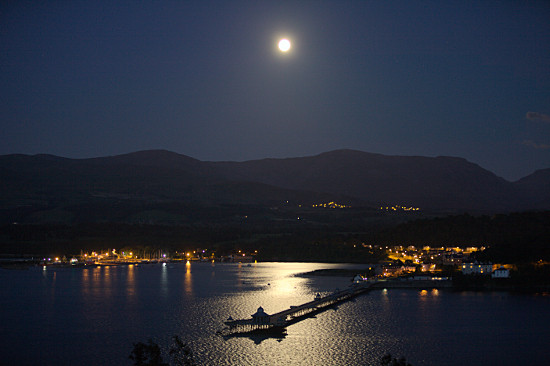
Last night the full moon shone from a clear, clear sky, casting long tree shadows on the drive and reflecting silver light onto the Strait and the pond on our terrace. Everything was still like a held breath.
Dorothy
3rd July 2015

Coed y Berclas, Anglesey Coast
A collection of award-winning luxury holiday accommodation. Stunning views overlooking the Menai Strait & Snowdonia

Last night the full moon shone from a clear, clear sky, casting long tree shadows on the drive and reflecting silver light onto the Strait and the pond on our terrace. Everything was still like a held breath.
Dorothy
3rd July 2015
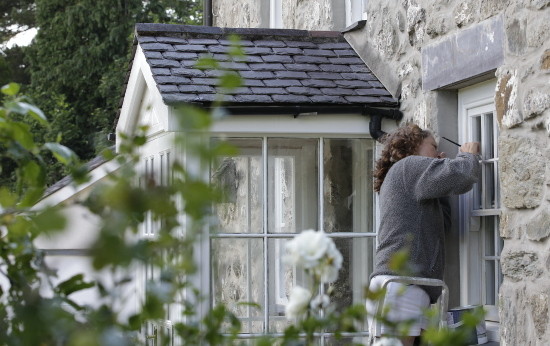
I’m doing one of my un-favourite jobs – painting the woodwork on the exterior of the Cottage. At the beginning of the week the paint and I were both sizzling. Today I was stopped by showers but as the evening has reverted to blue skies and sunshine, I’ll be back up my ladder as soon as I finish this blog. The Cottage is looking refreshed and prettier than ever! Bye bye for now – sunshine and a paint brush are calling me.
Dorothy
2nd July 2015
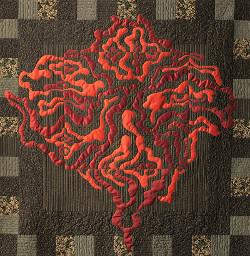
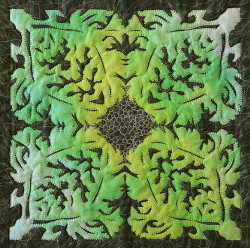
The weather seems to have settled into a calm sunny phase and we have had both morning coffee and lunch sitting on the terrace, stripped down to t-shirts and listening to birdsong. We did manage to fit some work in between!
It’s a good job we did – on Wednesday and Thursday this week we will be helping to put up my Exhibition, ‘Textiles in Transition’ in the Main Gallery at Oriel Ynys Mon (The Anglesey Gallery) in Llangefni: the opening is on Saturday 25th April between 12:00 and 14:00.
I’ll also be teaching two workshops in the gallery:
‘Folded Paper Applique’ on Tuesday 12th May 10:00 – 16:00
and
‘Notan’ on Monday 1st June 10:00 – 16:00.
The exhibition runs from 25th April until 7th June. If you’re on Anglesey please call in at the Oriel to see my work – it also has a gallery dedicated to Sir Kyffin Williams paintings and drawings, a history gallery which is very child friendly and a cafe. We’re very proud of Oriel Ynys Mon on Anglesey.
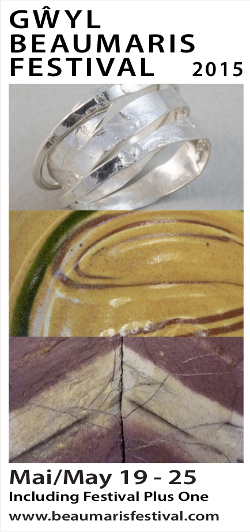
Beaumaris has an annual Festival which this year falls between 19th and 25th of May: it is very well renowned and concentrates on music with an international flavour, but also includes a craft fair, wood turning, poetry readings, lectures and an exhibition of art.
Beaumaris is such a beautiful little town, with its medieval castle, Victorian pier, historic buildings and lots of places to eat: the Festival is at home in these pleasant surroundings. Look for www.beaumaris festival.com
Enjoy… Dorothy Russell
21st April 2015

This morning, Daf and I sneaked a couple of hours off work – how dare we?! An acquaintance of ours opened a café in Bangor two days ago and we felt it was time to pop in to see how it was going.
I should explain – this is no ordinary café: Lesley is a personal trainer and dietary specialist who spotted a gap in the market – a very big gap: ‘Follow Your Bliss’ is entirely gluten-free and the food is all very carefully sourced.
Even the coffee is selected internationally, then roasted in Groeslon – look for ‘Poblado’ on the internet. I had an Americano (with lactose free milk) and a lemon macaroon and they were both superb – the coffee was the best I have tasted in a long time, possibly ever and the macaroon was fresh, moist and very tasty. Daf, with a larger appetite (nobody mentioned the work greedy!) had two coffees and a ‘Bliss Me Up’ sweet crepe with everything on it – I think it worked!!! It wasn’t even a guilty pleasure – all the ingredients were fresh and healthy.>

The café is small and very welcoming and whether you live gluten-free or not, we can heartily recommend a visit. We’ll be back, for sure!!!
You can find them at www.followyourblisspt.com 47 High Street, Bangor. LL57 1NR. 01248 361700.
Enjoy… Dorothy Russell
11th February 2015

Last week we had snow lying on Anglesey – a rare event – it has now retreated to the mountains where it really belongs and today we have had the most beautiful blue sky, sunny day, cold and fresh with not a cloud in the sky and wonderful views of the mountains. It has been perfect weather for walking and just being out of doors.
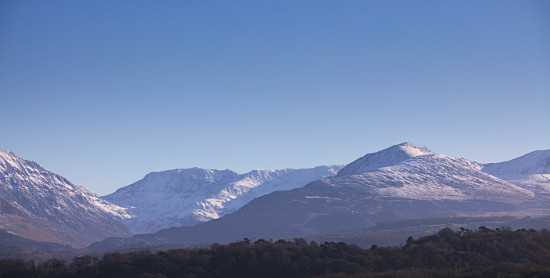
As the sun went down this evening, the snow changed from blue/white to delicate tints of pink and the softest of orange glows before the darkness decended. Then a blood red moon climbed into a starry sky, changing through orange to yellow then finally creamy white. These days are not uncommon at this time of year – their beauty make one feel so alive.
Dorothy Russell
6th February 2015
Last night was 5th November, the official Bonfire night, and we watched fireworks across the Strait on the mainland from the warmth and comfort of Coed y Berclas: however we are looking forward to Saturday 8th when Beaumaris holds a Firework bonanza which is always brilliant. We’ll be there, in fact Daf will probably be behind a camera as usual: he has produced some brilliant images in past years.
Tonight there’s a full moon but it doesn’t appear until after 10pm. We have recently noticed high tides which occur around the time of the full moon.
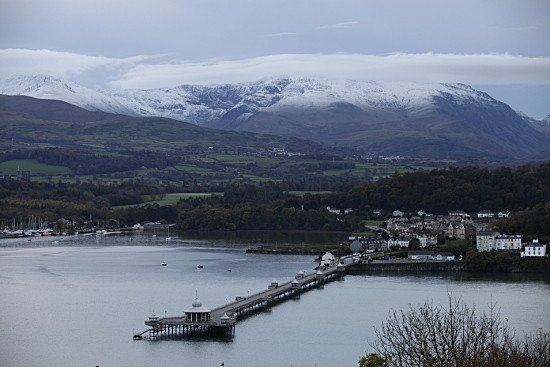
We have had some interesting weather recently: on Tuesday we saw the first snow on the tops of the mountains with a stunning blue sky: it looked beautiful. On Wednesday it has all vanished. We love looking over to Snowdonia capped with snow – we like it even better when there’s no snow on Anglesey, which is what usually happens.
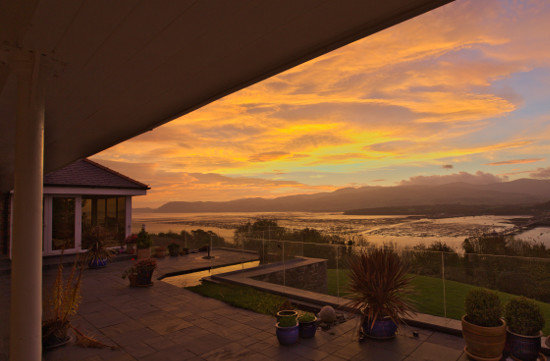
Dawn from a rather untidy Berclas main house terrace… bit of gardening to do then!!
Dorothy Russell
6th November 2014
I’m not sure where the year has gone – the Summer has been wonderfully busy and here we are approaching Autumn and the weather is very clement – we are frequently sitting outside for meals and I’m definitely topping up my tan. We both love being outside and, at the moment the birds are singing as though they think it’s Spring: I hope they aren’t getting confused. I have noticed swallows gathering on the wires and swooping around in swirls, catching their fill of insects in preparation for their long flight south.
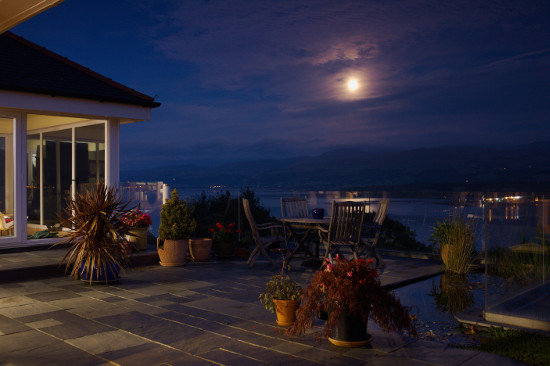
It has been perfect weather for walking too, and from Coed y Berclas we have seen the mountains of Snowdonia, starting their day capped with clouds or in a thin mist, which has burned off to leave them sharply defined against a blue sky. The view from the top of Snowdon must be beautiful in these conditions.
Tonight there is a full moon and it’s wonderful to watch from our terrace as it rises over the mountains. The reflections on the water, of its silvery light, are quite magical and it makes beautiful shadows on the drive of the tree behind the Cottage: we have no street lights to spoil it with light pollution.
Daf and I have just bought tickets for ‘Gardeners’ Question Time’ which will be recorded at the Canolfan (Leisure Centre) in Beauaris on the evening of 30th September. We’re really looking forward to seeing the team and putting faces to the voices we’ve heard so often on the radio. Daf’s working on his question but I’d like to relax and enjoy the occassion without worrying about someone pointing a microphone at me!
Before that is the Beaumaris Food Festival, on Saturday 13th and Sunday 14th. It promises to be great fun with demonstrations by top chefs in the Canolfan and 100 stalls around town selling street and artisan food and drinks.There will be a puffin trail for children and family entertainment on the pier. Beaumaris Castle will host a medieval event and the Castle, Gaol and Courthouse will charge half price entry fee, which can’t be bad.
Sadly, we missed the Menai Bridge Seafood Festival – we had a computer ‘melt-down’ which had to be sorted out. Luckily we had a report back from guests who said it was very busy and well worth going to – hopefully next year we’ll get there!
We have lots of happy memories and some lovely comments from guests who have stayed with us over the Spring and Summer – they have been out and about doing all sorts of different things, from walking parts of the Anglesey Coastal Path to cycling along country lanes, playing on sandy beaches to spotting red squirrels, flying through the air on zip wires to boat trips on Rib Ride, crabbing on Beaumaris pier to star-gazing from the orchard: there’s lots of information to read in the Visitors’ Book about their adventures and some lovely comments about Coed y Berclas too.
Dorothy Russell
8th September 2014
Access to the whole of Anglesey and Snowdonia is easy, with outdoor pursuits such as cycling, walking, kyaking, diving and sailing around the Anglesey coast. Llanddwyn beach, with it’s miles of south west facing sand and sea, Pilots Cove, two lighthouses and forest walks, is only 30minutes away.
Pubs and Restaurants for eating out are plentiful in the area, one shore side pub just 300 yards from the cottage has lovely views across the water.
Sitting in the orchard you can gaze at the stunning view endlessly: sailing boats on the sea, distant Lowryesque figures on Bangor Pier, mussel boats over the sandbanks, starlit skies on warm summer evenings… Owls, Jays, Pheasant and Raven live in the woodland beside the cottage… and Red Squirrels have been seen.
Walking from the cottage along the lane, where traffic is infrequent, there is a positively ‘old’ atmosphere. This is part of the Anglesey Coastal Path. There is a footpath into fields and woodland, for walkers who wish to leave the road, through an exquisite area of land where modern farming is impractical and small fields intersperse with woodland and gorse.
Further along the lane is Baron Hill Golf Club. The energetic could walk it from the cottage in 15 to 20mins. It is available for public use.

Anglesey is an internationally recognised Geopark: it has attracted geologists for centuries and there has been deep study and argument about the development of its fascinating structure. The island is one of the most geologically interesting areas within the UK.
Anglesey became an island around 10,000 years ago, after the last Ice Age, when ice melted and sea levels rose. There is a seismic fault which runs along the Menai Strait and there are occassional earth shocks or tremors – there was one in early 2015.
You don’t need to be a geologist to spend the day exploring the island’s stunning Coastal Path, or one of the many Geo Trails where you will see that our treasured rock formations come in all shapes and sizes, colours and structures and give vital clues to how the land has evolved.
These rocks span 4 eras and 12 geological periods and are often the reason behind the extraordinary range of plants and animals which call the island their home.,/p>
The Neolithic era saw the beginning of farming on Anglesey and therefore settlements, though evidence of this is rare: occassionally post holes, created by the historic presence of wooden house posts are discovered by archeologists. Other evidence from this period includes stone axe-heads, arrow-tips and spear-points: and on a much larger scale, the cromlechs (burial chambers), individual standing stones and henges (rings of stones).
You can visit Bryn Celli Ddu and Barclodiad y Gawres which are important examples of tombs which are still covered with earth mounds and can be entered through their tunnel openings. Both tombs contain carved stones in their interiors. The museum section of Oriel Ynys Mon contains a case of stone inmpements dating from this period.
Around 4,200 years ago, during the Bronze Age, our ancestors were already mining copper from Parys Mountain and using the metal to produce bronze tools and weapons. There are examples in Oriel Ynys Mon. Mynydd Parys (Parys Mountain) is a fascinating place to walk and to view the remains of mining through the centuries. There are other minerals to be found on the site and together they colour the landscape in different hues. (In the late C18th, under Thomas Williams, Parys Mountain became the greatest copper mine in the world.)
The Bronze Age also saw the development of defensive enclosures.
During the Iron Age, around 2,600 years ago, circular buildings of wattle and daub with long thatched roofs left sufficient archeologcal information for replicas to be built. You can see two ’round houses’ at Llandeusant close to LLynon windmill.
As time went by, low stone walls were built with similar conical thatched roofs: there are the remains of an evocative farming settlement with this type of buildings, Din Lligwy, at Llanallgo, near Moelfre – well worth visiting.
This is the time of the Celts and Druids, and Anglesey was the centre for Druidism in Britain, it was therefore a central focus for the many tribes around Britain, the means by which rebellion might flourish, and thus a threat to the Romans who were intent on adding Britain to their empire. Being an island, Anglesey felt protected from invasion, but against the military might of the Roman Empire it could not hold out.
One of the bloodiest massacres committed by the Romans occured on the south western shore between Moel y Don and Tal y Foel.
Under Seutonius Paulinus, the highly trained and battle hardened Roman army, with seige engines, cavalry, boats and better weapons and armour, set up camp, probably at Llanfairisgaer. At slack water, they used boats to cross the Menai Strait to attack the chanting, sheild clashing Celts. What followed was a rout and no prisoners were taken. Those who didn’t die in battle were put to the sword or burned to death.
Soon after his ‘victory’, Paullinus was called away to fight Boudicca and it wasn’t until 15 years later that Agricola crossed the Lavan Sands to Beaumaris to quell and settle Anglesey.
There are remains of a Roman fort in Holyhead – the parish church now stands within its walls – and a lookout tower, Mymydd Twr, on top of Holyhead Mountain.
The Celts remained on Anglesey after the Romans had left at the start of C5th AD and from this point Wales began to develop a seperate identity.
Christianity arrived around C4th AD and there are still Celtic crosses at Penmon Priory, which with Holyhead and Llaneilian were considered ‘mother churches’. There are also many smaller churches which may date from this period. Anglesey also had an abundance of saints and many place names begin with Llan (parish) followed by a saint’s name eg Llandegfan is the parish of St Tegfan.
The Vikings made raids on Anglesey, as they did around much of the northern coasts of the UK and Ireland. It’s likely that some Vikings settled on the fertile island: indeed, the name Anglesey is derived from Old Norse and was in use from the C10th AD.
The Normans also used the name when they attacked North Wales after conquering England. A Norman motte and bailey fort remains from this period at Aberlleniog near Llangoed.
Then followed the era of the Welsh Princes. Llewelyn Ap Iorwerth (Llewelyn the Great 1173 – 1240) was the most successful of the Welsh Princes, ruling not only Gwynedd but all Wales. He was married to Siwan (Joan), daughter of King John of England. Her carved stone coffin can be seen in the porch of the parish church in Beaumaris.
However, during the reign of the English King Edward I, Wales lost its independence with the death, in fighting, of Llewelyn Ap Gruffudd (the Last Prince).
Edward built several magnificent castles around North Wales to keep the people under control – they are open to the public now, looked after by CADW. Beaumaris Castle stands in the town, on the shore of the Menai Strait and is the magnificant, but unfinished last of Edward’s castles.
Although Owain Glyndwr’s Welsh rebels held the Castle from 1403 – 1405, in 1406 the English King Henry IV regained control of Anglesey.
One of the most famous families to come from Anglesey (Penmynydd) was the Tudors. Owain Tudor (c1400 – 1461) became a squire at the court of Henry V and on the king’s death Owain secretly married his French widow, Catherine de Valois. Their grandson became Henry VII after defeating the Yorkist King Richard III at Bosworth Field.
Both the Tudor and Stuart dynasties sprang from this root. Plas Penmynedd was built in 1576 for a later generation of the Tudors, probably in the same location as the earlier Tudor house. It still exists but is in private ownership.
In 1603, David Hughes, born locally but having left to ‘make his fortune’, founded a free grammar school for boys: the original building remains in Beaumaris and his name continues attached to Ysgol David Hughes, the comprehensive school in Menai Bridge, where it educates all children from the locality.
The Court (1614) and Gaol (1828/9) dealt with miscreants over the centuries: both buildings are open to the public in the centre of Beaumaris.
The Island’s main sources of income for centuries were fishing, farming, coastal shipping and ship building (and smuggling!). The Industrial Revolution brought larger ships and longer journeys and January 1826 saw the opening of Telford’s Menai Suspension Bridge, replacing ferries and the hazardous crossing from Abergwyngregyn to Beaumaris, and carrying the A5 (from London) to Holyhead, from whose port ships sailed for Dublin.
The railway followed when the Britannia Tubular Bridge opened in 1850. It was designed by William Fairbairn and George Stephenson and was the prototype of box girder construction.
In 1970 fire destroyed many of the tubular sections of the bridge. Turning disadvantage to advantage, the bridge was redesigned, with arches and an upper road level which was opened to traffic in 1980: it now carries the A55. Trains still run on the lower level, as previously.
Both bridges opened Anglesey up to more visitors and made travelling in both directions easier.
Throughout the C20th and up to the present we have welcomed visitors and enjoyed sharing the amazing features of our island with holiday-makers from all round the world. There is a warm Welsh welcome waiting here. Croeso i Ynys Mon (welcome to Anglesey)